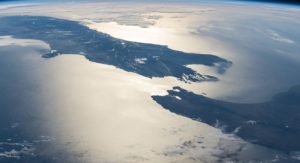
New Zealand’s Centre for Space Science Technology (CSST) announced on 12 November 2018 their role in facilitating their first international space mission partnership, as a calibration and validation (cal/val) partner for the NASA ECOSTRESS mission.
ECOSTRESS is a scientific mission that will measure the temperature of plants and use that information to better understand how much water plants need and how they respond to stress. The ECOSTRESS instrument, which is roughly the size of a refrigerator, is installed on the International Space Station. It captures temperature measurements of the Earth’s surface and sends the data back down to Earth.
The New Zealand cal/val partnership brings together researchers from University of Waikato, Manaaki Whenua – Landcare Research, and the National Institute of Water and Atmospheric Research (NIWA) to provide ECOSTRESS with essential ground measurements from New Zealand.
The partnership was formed when CSST reached out to NASA’s Jet Propulsion Laboratory (JPL) after identifying a unique opportunity for New Zealand researchers to contribute to ECOSTRESS. CSST liaised with JPL to understand the project requirements and has facilitated the collaboration of researchers from the three local partner organisations.
Each of the New Zealand partner organisations manage ecological research sites throughout our country, where tower-mounted sensors measure the exchanges of carbon dioxide, water vapour, methane, and other gases – exactly what is needed to calibrate and validate space-based measurements from ECOSTRESS.
Work is now underway at JPL to calibrate and validate the preliminary ECOSTRESS science data by comparing the spaceborne measurements with similar measurements made at ground control sites around the world. This quality control process is a critical component of all space-based missions and ensures that remote observations can be reliably tied to what is actually happening at the ground-level.
“The CSST and New Zealand researchers have established an important network of ecosystem measurements across a diverse landscape. This is important not only for understanding New Zealand’s rich ecology, but also for helping NASA to calibrate and validate similar measurements from space by ECOSTRESS,” said JPL scientist and ECOSTRESS science lead, Dr. Joshua Fisher.
By contributing to this mission, New Zealand researchers are playing a key role in both advancing scientific understanding of how plants use water; and enabling water managers, farmers, and policy-makers to utilise that data for better decision-making. Ultimately, this information could be used to protect the world’s vulnerable ecosystems while increasing agricultural yield and optimising forestry management.
“We are excited to be working with the New Zealand team and look forward to doing more work with them in the future,” said JPL scientist and ECOSTRESS calibration/validation lead, Dr. Kerry Cawse-Nicholson.
“We hope that this is the beginning of many science partnerships with key international space actors,” said Steve Cotter, CEO of CSST.
“It’s an exciting opportunity for us at CSST, but even more so for the whole of New Zealand, who will have free access to the data produced by ECOSTRESS and the opportunity to use that data for their own scientific research or to develop applications based on learnings from the collected data.”
Plant vitality and yield are inextricably linked to heat stress and water availability. Understanding how vegetation changes due to these stresses is the key science question being addressed by the NASA Jet Propulsion Laboratory (JPL) ECOsystem Spaceborne Thermal Radiometer Experiment on Space Station (ECOSTRESS) mission.
The instrument was launched into orbit on 29 June 2018 and installed on the International Space Station on 5 July 2018, where it will remain for at least 12 months.
“Applications of ECOSTRESS data for understanding and managing natural resources is something we are excited to see,” said JPL scientist and ECOSTRESS Applications Lead, Dr. Christine Lee. “This partnership is the ideal venue to demonstrate the benefit of remote sensing data in a practical way.”
Collectively, the New Zealand network of ground sites spans a diversity of land uses and climate, including wetland peat bog, irrigated and non-irrigated agricultural sites, and dairy pasture. This variety of well-characterised mini-environments makes New Zealand uniquely positioned to contribute to global science missions by providing calibration and validation of space-based measurements across ecological zones.
CSST is a regional research institute based in Alexandra, Central Otago. The organisation was established in May 2017 as part of the Ministry of Business, Innovation, and Employment’s Regional Research Institute Initiative.
CSST is an agile company that can handle the entire Earth observation data life-cycle, from system design, data capture, analysis and synthesis, data management, dissemination, through to training and support.





